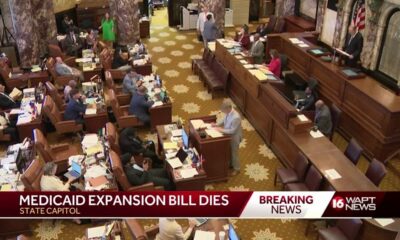Kaiser Health News
More Kids Are Dying of Drug Overdoses. Could Pediatricians Do More to Help?
Martha Bebinger, WBUR
Fri, 05 Apr 2024 09:00:00 +0000
A 17-year-old boy with shaggy blond hair stepped onto the scale at Tri-River Family Health Center in Uxbridge, Massachusetts.
After he was weighed, he headed for an exam room decorated with decals of planets and cartoon characters. A nurse checked his blood pressure. A pediatrician asked about school, home life, and his friendships.
This seemed like a routine teen checkup, the kind that happens in thousands of pediatric practices across the U.S. every day — until the doctor popped his next question.
“Any cravings for opioids at all?” asked pediatrician Safdar Medina. The patient shook his head.
“None, not at all?” Medina said again, to confirm.
“None,” said the boy named Sam, in a quiet but confident voice.
Only Sam's first name is being used for this article because if his full name were publicized he could face discrimination in housing and job searches based on his prior drug use.
Medina was treating Sam for an addiction to opioids. He prescribed a medication called buprenorphine, which curbs cravings for the more dangerous and addictive opioid pills. Sam's urine tests showed no signs of the Percocet or OxyContin pills he had been buying on Snapchat, the pills that fueled Sam's addiction.
“What makes me really proud of you, Sam, is how committed you are to getting better,” said Medina, whose practice is part of UMass Memorial Health.
The American Academy of Pediatrics recommends offering buprenorphine to teens addicted to opioids. But only 6% of pediatricians report ever doing do, according to survey results.
In fact, buprenorphine prescriptions for adolescents were declining as overdose deaths for 10- to 19-year-olds more than doubled. These overdoses, combined with accidental opioid poisonings among young children, have become the third-leading cause of death for U.S. children.
“We're really far from where we need to be and we're far on a couple of different fronts,” said Scott Hadland, the chief of adolescent medicine at Mass General for Children and a co-author of the study that surveyed pediatricians about addiction treatment.
That survey showed that many pediatricians don't think they have the right training or personnel for this type of care — although Medina and other pediatricians who do manage patients with addiction say they haven't had to hire any additional staff.
Some pediatricians responded to the survey by saying they don't have enough patients to justify learning about this type of care, or don't think it's a pediatrician's job.
“A lot of that has to do with training,” said Deepa Camenga, associate director for pediatric programs for the Yale Program in Addiction Medicine. “It's seen as something that's a very specialized area of medicine and, therefore, people are not exposed to it during routine medical training.”
Camenga and Hadland said medical schools and pediatric residency programs are working to add information to their curricula about substance use disorders, including how to discuss drug and alcohol use with children and teens.
But the curricula aren't changing fast enough to help the number of young people struggling with an addiction, not to mention those who die after taking just one pill.
In a twisted, deadly development, drug use among adolescents has declined — but drug-associated deaths are up.
The main culprits are fake Xanax, Adderall, or Percocet pills laced with the powerful opioid fentanyl. Nearly 25% of recent overdose deaths among 10- to 19-year-olds were traced to counterfeit pills.
“Fentanyl and counterfeit pills is really complicating our efforts to stop these overdoses,” said Andrew Terranella, the Centers for Disease Control and Prevention's expert on adolescent addiction medicine and overdose prevention. “Many times these kids are overdosing without any awareness of what they're taking.”
Terranella said pediatricians can help by stepping up screening for — and having conversations about — all types of drug use.
He also suggests pediatricians prescribe more naloxone, the nasal spray that can reverse an overdose. It's available over the counter, but Terranella, who practices in Tucson, Arizona, believes a prescription may carry more weight with patients.
Back in the exam room, Sam was about to get his first shot of Sublocade, an injection form of buprenorphine that lasts 30 days. Sam is switching to the shots because he didn't like the taste of Suboxone, oral strips of buprenorphine that he was supposed to dissolve under his tongue. He was spitting them out before he got a full dose.
Many doctors also prefer to prescribe the shots because patients don't have to remember to take them every day. But the injection is painful. Sam was surprised when he learned that it would be injected into his belly over the course of 20-30 seconds.
“Is it almost done?” Sam asked, while a nurse coaches him to breathe deeply. When it was over, staffers joked out loud that even adults usually swear when they get the shot. Sam said he didn't know that was allowed. He's mostly worried about any residual soreness that might interfere with his evening plans.
“Do you think I can snowboard tonight?” Sam asked the doctor.
“I totally think you can snowboard tonight,” Medina answered reassuringly.
Sam was going with a new buddy. Making new friends and cutting ties with his former social circle of teens who use drugs has been one of the hardest things, Sam said, since he entered rehab 15 months ago.
“Surrounding yourself with the right people is definitely a big thing you want to focus on,” Sam said. “That would be my biggest piece of advice.”
For Sam, finding addiction treatment in a medical office jammed with puzzles, toys, and picture books has not been as odd as he thought it would be.
He mom, Julie, had accompanied him to this appointment. She said she's grateful the family found a doctor who understands teens and substance use.
Before he started visiting the Tri-River Family Health Center, Sam had seven months of residential and outpatient treatment — without ever being offered buprenorphine to help control cravings and prevent relapse. Only 1 in 4 residential programs for youth offer it. When Sam's cravings for opioids returned, a counselor suggested Julie call Medina.
“Oh my gosh, I would have been having Sam here, like, two or three years ago,” Julie said. “Would it have changed the path? I don't know, but it would have been a more appropriate level of care for him.”
Some parents and pediatricians worry about starting a teenager on buprenorphine, which can produce side effects including long-term dependence. Pediatricians who prescribe the medication weigh the possible side effects against the threat of a fentanyl overdose.
“In this era, where young people are dying at truly unprecedented rates of opioid overdose, it's really critical that we save lives,” said Hadland. “And we know that buprenorphine is a medication that saves lives.”
Addiction care can take a lot of time for a pediatrician. Sam and Medina text several times a week. Medina stresses that any exchange that Sam asks to be kept confidential is not shared.
Medina said treating substance use disorder is one of the most rewarding things he does.
“If we can take care of it,” he said, “We have produced an adult that will no longer have a lifetime of these challenges to worry about.”
This article is from a partnership that includes WBUR, NPR, and KFF Health News.
——————————
By: Martha Bebinger, WBUR
Title: More Kids Are Dying of Drug Overdoses. Could Pediatricians Do More to Help?
Sourced From: kffhealthnews.org/news/article/buprenorphine-children-teens-pediatricians-substance-use-disorder/
Published Date: Fri, 05 Apr 2024 09:00:00 +0000
Did you miss our previous article…
https://www.biloxinewsevents.com/dietary-choices-are-linked-to-higher-rates-of-preeclampsia-among-latinas/
Kaiser Health News
KFF Health News’ ‘What the Health?’: Abortion Access Changing Again in Florida and Arizona
Thu, 02 May 2024 19:30:00 +0000
The Host
Julie Rovner
KFF Health News
Julie Rovner is chief Washington correspondent and host of KFF Health News' weekly health policy news podcast, “What the Health?” A noted expert on health policy issues, Julie is the author of the critically praised reference book “Health Care Politics and Policy A to Z,” now in its third edition.
The national abortion landscape was shaken again this week as Florida's six-week abortion ban took effect. That leaves North Carolina and Virginia as the lone Southern states where abortion remains widely available. Clinics in those states already were overflowing with patients from across the region.
Meanwhile, in a wide-ranging interview with Time magazine, former President Donald Trump took credit for appointing the Supreme Court justices who overturned Roe v. Wade, but he steadfastly refused to say what he might do on the abortion issue if he is returned to office.
This week's panelists are Julie Rovner of KFF Health News, Sarah Karlin-Smith of the Pink Sheet, Alice Miranda Ollstein of Politico, and Rachana Pradhan of KFF Health News.
Panelists
Sarah Karlin-Smith
Pink Sheet
Alice Miranda Ollstein
Politico
Rachana Pradhan
KFF Health News
Among the takeaways from this week's episode:
- Florida's new, six-week abortion ban is a big deal for the entire South, as the state had been an abortion haven for patients as other states cut access to the procedure. Some clinics in North Carolina and southern Virginia are considering expansions to their waiting and recovery rooms to accommodate patients who now must travel there for care. This also means, though, that those traveling patients could make waits even longer for local patients, including many who rely on the clinics for non-abortion services.
- Passage of a bill to repeal Arizona's near-total abortion ban nonetheless leaves the state's patients and providers with plenty of uncertainty — including whether the ban will temporarily take effect anyway. Plus, voters in Arizona, as well as those in Florida, will have an opportunity in November to weigh in on whether the procedure should be available in their state.
- The FDA's decision that laboratory-developed tests must be subject to the same regulatory scrutiny as medical devices comes as the tests have become more prevalent — and as concerns have grown amid high-profile examples of problems occurring because they evaded federal review. (See: Theranos.) There's a reasonable chance the FDA will be sued over whether it has the authority to make these changes without congressional action.
- Also, the Biden administration has quietly decided to shelve a potential ban on menthol cigarettes. The issue raised tensions over its links between health and criminal justice, and it ultimately appears to have run into electoral-year headwinds that prompted the administration to put it aside rather than risk alienating Black voters.
- In drug news, the Federal Trade Commission is challenging what it sees as “junk” patents that make it tougher for generics to come to market, and another court ruling delivers bad news for the pharmaceutical industry's fight against Medicare drug negotiations.
Plus, for “extra credit” the panelists suggest health policy stories they read this week that they think you should read, too:
Julie Rovner: ProPublica's “A Doctor at Cigna Said Her Bosses Pressured Her To Review Patients' Cases Too Quickly. Cigna Threatened To Fire Her,” by Patrick Rucker, The Capitol Forum, and David Armstrong, ProPublica.
Alice Miranda Ollstein: The Associated Press' “Dozens of Deaths Reveal Risks of Injecting Sedatives Into People Restrained by Police,” by Ryan J. Foley, Carla K. Johnson, and Shelby Lum.
Sarah Karlin-Smith: The Atlantic's “America's Infectious-Disease Barometer Is Off,” by Katherine J. Wu.
Rachana Pradhan: The Wall Street Journal's “Millions of American Kids Are Caregivers Now: ‘The Hardest Part Is That I'm Only 17,” by Clare Ansberry.
Also mentioned on this week's podcast:
- Time's “How Far Trump Would Go,” by Eric Cortellessa.
- NPR's “Why Is a 6-Week Abortion Ban Nearly a Total Ban? It's About How We Date a Pregnancy,” by Selena Simmons-Duffin.
- NPR's “'Sicko's' Peeno Sees Few Gains in Health Insurance,” by Julie Rovner.
- CNN's “Walmart Will Close All of Its Health Care Clinics,” by Nathaniel Meyersohn.
Credits
Francis Ying
Audio producer
Emmarie Huetteman
Editor
To hear all our podcasts, click here.
And subscribe to KFF Health News' “What the Health?” on Spotify, Apple Podcasts, Pocket Casts, or wherever you listen to podcasts.
——————————
Title: KFF Health News' ‘What the Health?': Abortion Access Changing Again in Florida and Arizona
Sourced From: kffhealthnews.org/news/podcast/what-the-health-345-abortion-access-florida-arizona-may-2-2024/
Published Date: Thu, 02 May 2024 19:30:00 +0000
Kaiser Health News
DIY Gel Manicures May Harm Your Health
Tarena Lofton
Thu, 02 May 2024 09:00:00 +0000
A fresh set from the comfort of your own home? DIY gel nails have been all the rage on social media, but the practice could cause you to develop a life-changing allergy. In a TikTok video, creator @alina.gene describes developing an acrylate allergy from doing gel nails at home. Now, when exposed to acrylates, the creator feels severe pain.
The creator warns viewers not to self-apply nail polish that requires a UV light to cure. In later videos, @alina.gene explains that at-home use differs from in-salon use because salon professionals have access to higher-quality chemicals that are less likely to cause reactions and that they also have proper training on how to safely apply the products.
“I know I sound real dramatic because an allergy to gel nails or even an allergy to acrylates isn't going to kill you, but the thing is, in the wrong situation it could prevent you from getting lifesaving medical care,” said @alina.gene in another video. Common medical products contain acrylates, and developing this allergy can cause major issues in obtaining future medical care.
We asked an allergist to walk us through this viral video.
If you enjoyed this story from the KFF Health News social team, follow us on Instagram @KFFHealthNews.
✍️: KFF Health News Audience Engagement Team
——————————
By: Tarena Lofton
Title: DIY Gel Manicures May Harm Your Health
Sourced From: kffhealthnews.org/news/article/diy-gel-manicures-health-risks/
Published Date: Thu, 02 May 2024 09:00:00 +0000
Did you miss our previous article…
https://www.biloxinewsevents.com/robert-f-kennedy-jr-is-wrong-about-a-ban-on-nih-research-about-mass-shootings/
Kaiser Health News
Robert F. Kennedy Jr. Is Wrong About a Ban on NIH Research About Mass Shootings
Louis Jacobson, PolitiFact
Thu, 02 May 2024 09:00:00 +0000
“Congress prohibits the NIH from researching the cause of mass shootings.”
Robert F. Kennedy Jr. in an April 21 post on X
The National Institutes of Health is the federal government's main agency for supporting medical research. Is it barred from researching mass shootings? That's what presidential candidate Robert F. Kennedy Jr. said recently.
Kennedy, whose statements about conspiracy theories earned him PolitiFact's 2023 “Lie of the Year,” is running as an independent third-party candidate against President Joe Biden, the presumptive Democratic candidate, and the presumptive Republican nominee, former President Donald Trump.
On April 21 on X, Kennedy flagged his recent interview with conservative commentator Glenn Beck, which touched on gun policy. Kennedy summarized his gun policy views in the post, writing, “The National Institutes of Health refuses to investigate the mystery; in fact, Congress prohibits the NIH from researching the cause of mass shootings. Under my administration, that rule ends — and our kids' safety becomes a top priority.”
But this information is outdated.
In 1996, Congress passed the “Dickey Amendment,” an appropriations bill provision that federal officials widely interpreted as barring federally funded research related to gun violence (though some observers say this was a misinterpretation). Congress in 2018 clarified that the provision didn't bar federally funded gun-related research, and funding for such efforts has been flowing since 2020.
Kennedy's campaign did not provide evidence to support his statement.
What Was the Dickey Amendment?
After criticizing some federally funded research papers on firearms in the mid-1990s, pro-gun advocates, including the National Rifle Association, lobbied to halt federal government funding for gun violence research.
In 1996, Congress approved appropriations bill language saying that “none of the funds made available for injury prevention and control at the Centers for Disease Control and Prevention may be used to advocate or promote gun control.” The language was named for one of its backers, Rep. Jay Dickey (R-Ark).
But the Dickey Amendment, as written, did not ban all gun-related research outright.
“Any honest research that was not rigged to produce results that helped promote gun control could be funded by CDC,” said Gary Kleck, a Florida State University criminologist. But CDC officials, experts said, interpreted the Dickey Amendment as banning all gun-related research funding.
This perception meant the amendment “had a chilling effect on funding for gun research,” said Allen Rostron, a University of Missouri-Kansas City law professor who has written about the amendment. Federal agencies “did not want to take a chance on funding research that might be seen as violating the restriction” and so “essentially were not funding research on gun violence.”
Also, the Dickey Amendment targeted only the CDC, not all other federal agencies. Congress expanded the restriction to cover NIH-funded research in 2011.
Although the Dickey Amendment didn't bar gun-related research, federal decision-makers acted as though it did by not pursuing such research.
Moving Past the Dickey Amendment
Over time, critics of the gun industry made an issue of the Dickey Amendment and gathered congressional support to clarify the amendment.
In 2018, lawmakers approved language that said the amendment wasn't a blanket ban on federally funded gun violence research. By 2020, federal research grants on firearms began to be issued again, starting with $25 million to be split between the CDC and NIH.
By now, the CDC and NIH are funding a “large portfolio” of firearm violence-related research, said Daniel Webster, a professor at the Johns Hopkins Bloomberg School of Public Health.
Also, the Justice Department's National Institute of Justice has funded the largest study of mass shootings to date, Webster said, and is seeking applications for studies of mass shootings.
Our Ruling
Kennedy said, “Congress prohibits the NIH from researching the cause of mass shootings.”
Although the Dickey Amendment, a provision of appropriations law supported by the gun industry, didn't prohibit all federally supported, gun-related research from 1996 to 2018, decision-makers acted as though it did.
However, in 2018, Congress clarified the provision's language. And since 2020, CDC, NIH, and other federal agencies have funded millions of dollars in gun-related research, including studies on mass shootings.
We rate Kennedy's statement False.
Our Sources
Robert F. Kennedy Jr. post on X, April 21, 2024
National Institutes of Health, “NIH Awards Additional Research and Training Grants to Support Firearm Injury and Mortality Prevention Science,” Sept. 20, 2023
National Institute of Justice, “Public Mass Shootings: Database Amasses Details of a Half Century of U.S. Mass Shootings with Firearms, Generating Psychosocial Histories,” Feb. 3, 2022
National Institute of Justice, “NIJ FY24 Research and Evaluation on Firearm Violence and Mass Shootings,” Feb. 5, 2024
Centers for Disease Control and Prevention, “Funded Research,” accessed April 22, 2024
American Psychological Association, “A Thaw in the Freeze on Federal Funding for Gun Violence and Injury Prevention Research,” April 1, 2021
Allen Rostron, “The Dickey Amendment on Federal Funding for Research on Gun Violence: A Legal Dissection” (American Journal of Public Health), July 2018
Email interview with Gary Kleck, a Florida State University criminologist, April 22, 2024
Email interview with Daniel W. Webster, professor at the Johns Hopkins Bloomberg School of Public Health, April 22, 2024
Email interview with Jaclyn Schildkraut, executive director of the Regional Gun Violence Research Consortium at the Rockefeller Institute of Government, April 22, 2024
Email interview with Mike Lawlor, University of New Haven criminologist, April 22, 2024
Email interview with Allen Rostron, University of Missouri-Kansas City law professor, April 22, 2024
KFF Health News is a national newsroom that produces in-depth journalism about health issues and is one of the core operating programs at KFF—an independent source of health policy research, polling, and journalism. Learn more about KFF.
USE OUR CONTENT
This story can be republished for free (details).
——————————
By: Louis Jacobson, PolitiFact
Title: Robert F. Kennedy Jr. Is Wrong About a Ban on NIH Research About Mass Shootings
Sourced From: kffhealthnews.org/news/article/fact-check-rfk-jr-wrong-nih-research-mass-shootings-gun-control-dickey-amendment/
Published Date: Thu, 02 May 2024 09:00:00 +0000
Did you miss our previous article…
https://www.biloxinewsevents.com/breaking-a-promise-california-deficit-could-halt-raises-for-disability-workers/
-
Mississippi Today5 days ago
On this day in 1951
-
Mississippi News6 days ago
One injured in Mississippi officer-involved shooting after chase
-
SuperTalk FM3 days ago
Festival merger in Leland sets up one major event for Mississippi Delta
-
SuperTalk FM4 days ago
PERS bill set to phase in employer rate increase heads to governor’s desk
-
Mississippi Business2 days ago
Geartek expanding operations in Alcorn County
-
Mississippi News3 days ago
Two women accused of shoplifting across southeast captured in Mississippi
-
SuperTalk FM6 days ago
Investigation underway after gun found in backpack of Ridgeland High School student
-
SuperTalk FM13 hours ago
Driver’s education set to become mandatory in Mississippi as bill passes




































